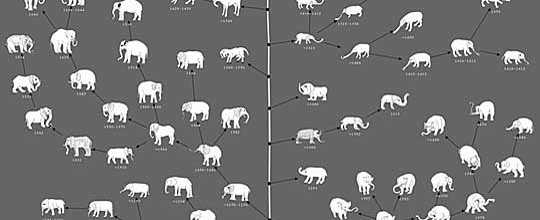Genealogien Arbeiten von Uli Westphal
June 4th – October 11th 2009
The works of Berlin
artist Uli Westphal are closely related to Biology and its
classification-systems, but set emphasis on different subject matters.
For example, instead of showing the genealogy of elephants, he
visualizes the development of their depictions. The works stand in a
dialog between culture and science. He poses questions on how nature is
perceived, depicted and understood in these different contexts. His
works derive from collections, simulations, animations and
classification-systems. These are based on actual, existing, natural
phenomena, but they tell most of all about the development of human
conceptions of nature.
A peculiarity of this exhibition is the
integration of three of Westphals works into the permanent exhibition
of the museum.
The work Elephas Anthropogenus investigates the depictions that Western-Europeans have made of the elephant during the course of history.
Since there was no real knowledge during the middle ages, of how this
animal actually looked, illustrators had to rely on oral and written
transmissions, to morphologically reconstruct the elephant - thus
reinventing an actual existing creature. This led to illustrations that
still show the basic features of an elephant, but that otherwise
completely deviate from the actual appearance and body shape of this
animal. Based on a collection of such depictions, the work traces the
evolution of Elephas Anthropogenus,
the man-made elephant. The result is a genealogical tree diagram, in
which the imagery is arranged according to taxonomic aspects.
In
this case Westphal uses the visual language of natural science to give
form and structure to the development of a cultural image of nature.
The work Mutatoes deals with contemporary perception of nature. The Mutato-Archive
is an extensive photographic collection of non-standardized fruit,
roots, fungi and vegetables. Edible plants have developed, especially
due to the industrialization of agriculture, into organisms whose
morphology is shaped by societal ideals of beauty and perfection.
Today we have a clearly defined idea of how, for example, an apple or a tomato should look.
We encounter variations and deviations from this well accustomed norm mostly with mistrust.
Westphal uses the word 'mutatoes' as a collective term that comprises
all produce that contradicts these optical guidelines. The aggregation
of these specimens into a larger collection reveals the strict borders
that man has drawn between the cultivated and the wild.
The Mutato-Archive
serves to remind us of the great variety of shapes that, as a
consequence of this segregation, fall into oblivion until they
eventually disappear.
The work Coleoptera is an animation produced by the fast
progression of over 2000 silhouettes of different beetle-species. The
individual beetle silhouettes are sorted according to their
body-shapes, so that the slight variations in their appearance create a
raw impression of movement. The different species turn into a single
but constantly transmutating organism.
Beetles form the biggest order of insects and account for about 25% of all described species.
The work Coleoptera
is an attempt to make the immensity of this biodiversity
comprehensible. It does so by using a purely visual, and therefore
rather subjective classification.
The work is a collaboration with the American artist Kristen Cooper.
The work Chimaerama is a sort of random generator that
recombines segments of hundred Victorian animal-illustrations into one
million new creatures. A 22 hour long film shows these combinations at
a rate of 12.5 images per second. This flow of images can be paused by
means of a switch - like in a slotmachine - and the chimera that was
generated in this moment becomes visible.
The work refers to elements from zoology as well as from the history of science:
In past centuries, people used to describe a new found animal-species
by combining the body parts of already known animals. A sea lion, for
example, was described as a dog with feet like those of a goose and
skin like that of an eel. As a generator of novel lifeforms, the work
also deals with crossbreeding as a driving force of evolution: The
constant shuffling of genetic makeup forms a major aspect of
evolutionary processes.
Westphals
works show that the need to structure the world, to group things into
classification-systems and families is not only a peculiarity of the
natural sciences. These mechanisms help us to understand the complexity
of the world and to divide it into smaller, more manageable entities.
They can therefore also be used in cultural contexts as tools of
cognition. These systems however, remain artificial constructions,
whose forms are dependent on the meaning and function that we give
them.
Westphals works integrate themselves very well into the
context of the Phyletisches Museum, which was founded by Ernst Haeckel
as a place dedicated to the meeting of art and science.
More Informations on the artist and the exhibited works can be found here.



